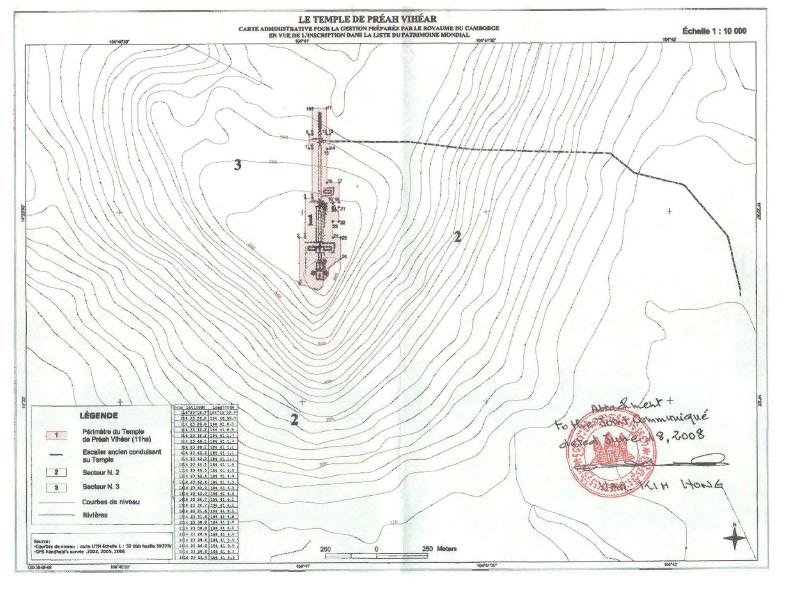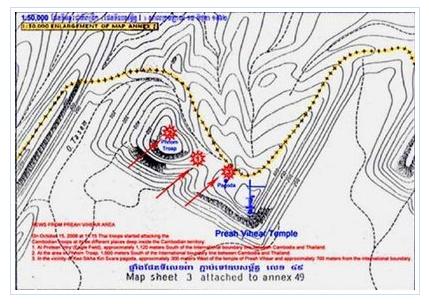The Mirror, Vol. 13, No. 618
At a time of increased tension at the border to Thailand, it is appropriate to remember again how the drafters of the Constitution of 1993, and those elected representatives who accepted it, described their vision of Kingdom of Cambodia in the Preamble of the Constitution:
Having endured sufferings and destructions and having experienced a tragic decline in the course of the two decades,
Having awakened, stood up with a resolute determination to strengthen the national unity, to preserve and defend Cambodia’s territory and its precious sovereignty and the prestige of Angkor civilization, and to restore Cambodia into an “Island of Peace” based on a multi-party liberal democratic regime guaranteeing human rights and the respect of law, and responsible for the destiny of the nation always evolving toward progress, development, prosperity, and glory,
WITH THIS RESOLUTE WILL We inscribe the following as the Constitution of the Kingdom of Cambodia.
These words with the call for national unity were issued in 1993, while the armed and bloody conflict with one of Cambodia’s political groups – the Khmer Rouge – was still continuing in some parts of the country, even until 1996, against those who had joined to write this constitution.
After the sufferings and the destruction and a tragic decline – now a democratic, multi-party democracy where human rights and the law are respected: an Island of Peace!
How can this be upheld, when we had, during the past week, headlines like the following:
- Cambodia Makes Every Possible Preparation, Including the Deployment of Troops, to Withstand a Thai Invasion
- Hun Sen: I Am a Hot-Minded Person but Thoughtful in Taking Decisions to Avoid Bloodshed
- Thailand Agrees to Reduce the Number of Soldiers at the Chak Chreng Area, and Thai Prime Minister Abhisit Sends a Deputy Prime Minister for Negotiations
- Samdech Dekchor: I Accept Only One Explanation when the Thai Deputy Prime Minister comes to negotiate with Cambodia: That Is to Withdraw Thai Troops from Cambodia
- The Khmer and the Thai Military Accuse Each Other over the Increase of Troops and Weapons along the Border
And later it was only reported that the Cambodian prime minister and the Thai deputy prime minister had met for two hours, after the Cambodian prime minister had said that the Preah Vihear temple status would not be on the agenda, but the Thai visitor could “raise the issue of withdrawing Thai troops from the border,” or, according to other reports, “to withdraw Thai troops from Cambodian territory.”
Unfortunately, the tension is still mounting, in spite of the declarations of the two prime ministers on 12 June 2009, to do everything to avoid armed conflicts, and rather expand cooperation between both countries in many fields. We had mirrored a report under the title A Meeting between Hun Sen and Abhisit Vejjajiva Leads to Many Good Results and Proceeds in Good Atmosphere
When such declarations of goodwill at the highest level are made public, they normally do not say whether and what kind of the crucial, still open details were discussed.
The present new round of tensions after the meeting of the two prime ministers was triggered by a Thai statement that Thailand wants to initiate discussions about the joint development of the area of the Preah Vihear temple, in the border area between both countries – a well frequented tourist site before the confrontation which started after Preah Vihear had been declared a UNESCO World Heritage Site in July 2008. The temple is located on uncontested Cambodian territory since the International Court of Justice declared this in 1962, but it is surrounded by an area contested between both countries, easily accessible only from Thailand, as it is situated on a high plain extending into Thailand, about 500 meter above the uncontested Cambodian territory to the south.
What is surprising in this respect is the fact that the Preah Vihear issue is treated quite differently in both countries, in terms of the very different involvements of the parliaments of both countries, and in terms of the information to the public about important details of the UNESCO World Heritage Committee decisions in 2008.
The results of the negotiations – prior to the decisions of the UNESCO committee – were scrutinized by the Thai parliament. The Thai Minister of Foreign Affairs, Noppadon Pattama, had to tender his resignation, because he had acted on international affairs that need the consent of the Thai parliament according to the Thai constitution. But he had not asked parliament for the necessary authorization.
On the other side, we are not aware when, or that, the Cambodian submissions were discussed in the Cambodian National Assembly. Even the map, presented by the Cambodian high level delegation, by Deputy Prime Minister Sok An, and Senior Minister and head of the Cambodian Border Commission, Var Kim Hong, on 18 June 2008, was not even published in the Cambodian media, though it was an annex to a text with the grave implications:

Map presented by the Cambodian side on 18 June 2008
1. The Kingdom of Thailand supports the inscription, at the 32th session of the World Heritage Committee (Québec, Canada, July 2008), of the Temple of Preah Vihear on the World Heritage List proposed by the Kingdom of Cambodia, the perimeter of which is identified as N. 1 in the map prepared by the Cambodian authorities and herewith attached. The map also includes, identified as N.2, a buffer zone to the East and South of the Temple.
2.In the spirit of goodwill and conciliation, the Kingdom of Cambodia accepts that the Temple of Preah Vihear be nominated for inscription on the World Heritage List without at this stage a buffer zone on the northern and western areas of the Temple.
The adjacent map shows that only the narrow – probably 30 meters – area around the Preah Vihear Temple was claimed “at this stage.”

Map of clashes in the contested buffer zones.
Most of the military clashes since happened in the “buffer zones” to the north and west of Preah Vihear – in the buffer zones which are contested areas. Both sides claim them as their territory.
What is more surprising is the fact that there is a strong emotionally commitment in the Cambodian public to maintain the Cambodian interests related to the Preah Vihear temple, while the public has not been informed through the media about important submissions by the Cambodian delegation (some of the documents published in English and French, and subsequently translated also into Spanish and Arab, to get the necessary UNESCO committee members’ votes) have not been translated into the Khmer language for the public. We reprint here part of the final decisions – only a part of long, legal texts – which have been accepted by the Cambodian government delegation in July 2008.
The World Heritage Committee,
Decides, on an exceptional basis, to accept, in view of the multilateral process leading to the elaboration of the supplementary report submitted in May 2008 by the State Party of Cambodia at the request of the UNESCO World Heritage Centre, the information submitted by the State Party beyond the deadline established in the paragraph 148 of the Operational Guidelines;
Recognizes that Thailand has repeatedly expressed a desire to participate in a joint nomination of the Temple of Preah Vihear and its surrounding areas;
Notes that the property proposed for inscription is reduced and comprises only the Temple of Preah Vihear and not the wider promontory with its cliffs and caves;
Encourages Cambodia to collaborate with Thailand for safeguarding the value of the property, in view of the fact that peoples of the surrounding region have long treasured the Temple of Preah Vihear, and agrees that it would be desirable in the future to reflect its full values and landscape setting through a possible additional inscription to the World Heritage List that could capture criteria (iii) and (iv), which had been recognized by the Committee in its Decision 31 COM 8B.24.
Requests the State Party of Cambodia, in collaboration with UNESCO, to convene an international coordinating committee for the safeguarding and development of the property no later than February 2009, inviting the participation of the Government of Thailand and not more than seven other appropriate international partners, to examine general policy matters relating to the safeguarding of the Outstanding Universal Value of the property in conformity with international conservation standards;
Requests the State Party of Cambodia to submit to the World Heritage Centre, by 1 February 2009, the following documents:
a)a provisional map providing additional details of the inscribed property and a map delineating the buffer zone identified in the RGPP;
b)updated Nomination dossier to reflect the changes made to the perimeter of the property;
c)confirmation that the management zone for the property will include the inscribed property and buffer zone identified in the RGPP;
d)progress report on the preparation of the Management Plan;
Further requests the State Party of Cambodia to submit to the World Heritage Centre by February 2010, for submission to the World Heritage Committee at its 34th session in 2010 a full Management Plan for the inscribed property, including a finalized map.
Any reference by Thai representatives to a joint management of the Preah Vihear Temple area – by Cambodia and by Thailand – has been flatly rejected in the Cambodian public. But that is what the Cambodian delegation had agreed upon, when Preah Vihear was made a World Heritage Site, according to the minutes of this UNESCO committee. And according to the same mutually agreed upon decision by the UNESCO World Heritage Committee, the decision is up to be reviewed in 2010, in view of the joint management plan to elaborated by both governments.
The more time passes, the more it would be important that the Cambodian public is informed – publicly and in the Cambodian language – about the commitments made towards a joint administration of the Preah Vihear area. It had been an important tourism site, and it was expected it would receive more attention and more visitors after being made a World Heritage Site. Instead, tourism came to an almost complete standstill, and several persons from both sides of the border have lost their lives.
Please recommend us also to your colleagues and friends.

Recent Comments